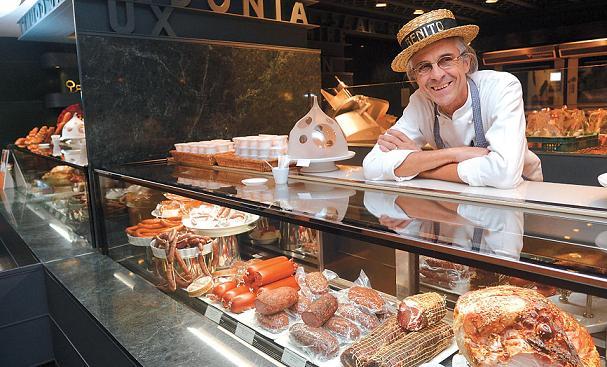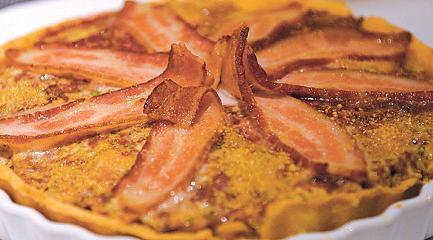 |
Belgian charcutier Benito Plasschaert poses for a photo behind the charcuterie product display at The Deli of Grand Hyatt Seoul. (Lee Sang-sub/The Korea Herald) |
When Belgian charcutier Benito Plasschaert visited Korea 20 years ago to train staff at a major hotel in Seoul, perhaps no one had ever heard of charcuterie or tasted meat products other than ham.
But when he returned last year and again this year for the promotion of prepared meat products at Grand Hyatt Seoul, he was surprised to see people waiting for him and his products ranging from sausages and hams to more unfamiliar products such as pates, terrines, rilletes and meatloaf. Plasschaert presents some of these now popular charcuterie products at The Deli at Grand Hyatt Seoul until Dec. 9.
“Twenty years ago, only foreign people ate sausages and bacon in the morning at hotels,” said Plasschaert in an interview with The Korea Herald on Monday.
“A young man came to me yesterday and said he was happy to see me again. He bought five pates and other products,” he added.
Charcuterie culture started in France where people came up with special culinary techniques to consume pork leftovers. In French, the verb “charcuter” means to cut up meat. After years of experimenting with various ingredients such as vegetables, eggs and pastry crusts, today’s charcuterie products are made of forcemeat made from pork, beef, chicken and goose liver.
Plasschaert, with more than 45 years of experience in charcuterie, travels all around the world to teach charcuterie. His next stop after Korea is the Maldives.
The award-winning charcutier used to own a shop in Belgium which sold over 60 kinds of pates and 45 cooked hams, 10 times more than he serves at the hotel. But he closed the shop four years ago when his wife Nadya got sick in order to care for her.
The couple now runs a charcuterie consulting and training service and travels around the world to pass on their charcuterie know-how.
Asked if he’s okay with giving away some of his own recipes, he said: “My grandchildren find my recipe in Mumbai and other cities and say ‘this is my grandfather!’”
The Deli promotes charcuterie products for the Christmas holiday season, but Plasschaert said it is enjoyed all year round in Europe, especially in Belgium.
“People start going hunting from October through January and during this time, people make charcuterie products,” he said, adding people make a special charcuterie product with venison and other ingredients including chestnuts for the holiday season.
“People like to have special items for Christmas. And just like people drink champagne to celebrate holidays, we have charcuterie products,” he said.
Plassacheart shared his own meatloaf recipe that is simple and easy to make at home for The Korea Herald readers for the holiday season.
 |
“Mini cumberland tartlet,” a meatloaf cooked by Plasschaert (Lee Sang-sub/The Korea Herald) |
Mini Cumberland Tartlet
― Start to finish: 50 minutes
― Servings: 5
― Ingredients: 700 g ground chicken, 400 g ground beef, 200 g boiled egg (chopped), 20 g soya flour, 2 raw eggs, 8 slices of bacon, 50 g mustard seed, a tart case, 20 g parsley (chopped), 12 g salt, 2 g pepper, 2 g sage.
Directions:
― Heat the oven to 120 degrees Celsius.
― Put ground chicken, soya flour and raw eggs in a household mixer with sharp knives. A paste will form to help the chicken and beef stick together. Make sure the temperature doesn’t rise above 12 degrees Celsius.
― Mix in a bowl with ground beef, boiled eggs, chopped parsley, salt, pepper and sage. The bowl should be placed on ice to keep the meat temperature cold.
― Spoon into the prepared tart case and make sure there are no air bubbles. Top with bacon slices.
― Bake in the oven for 40 minutes.
When taken out, the inside of the meatloaf should be 68 degrees Celsius.
By Lee Woo-young (
wylee@heraldcorp.com)









